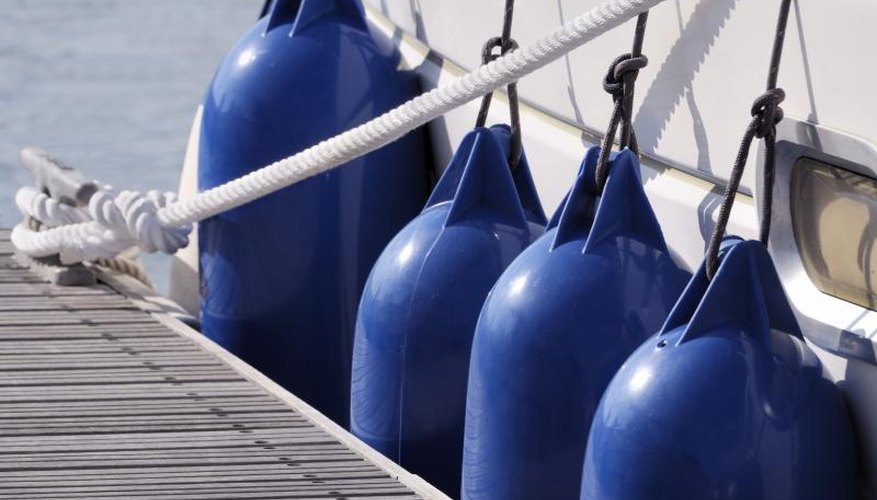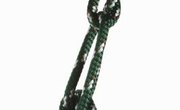
Fenders are as good as their name -- they push the pristine hull of your precious boat away from any object that might ding, scratch, gouge or scrape the paint, fiberglass, brass or wood. Put out your fenders when tied up at a dock, rafting with other boats, transiting a lock, or keeping the dinghy from clunking into the mothership.
Items you will need
Line
Fenderboard (optional)
Ways to Wear the Fender
Step 1
Attach your fenders to the boat, not the dock, to the lowest possible cleat or stanchion, so they hang just above the waterline. Fenders tied to the boat protect the hull as the tide rises and falls because they are always at the point where the hull would contact another surface. You can easily adjust boat-tied fenders when you're on board. Tying the fender on with as little line as possible prevents a large arc and a swinging fender that can flop onto a dock or deck, or be squeezed out of place and expose the hull to damage.
Step 2
Position a large, round, inflated fender at the widest point of the beam dockside when securely fastened fore and aft in a calm marina, to hold the boat away from the dock. Or tie three ribbed cylindrical fenders vertically -- one fore, one aft and one at the beam midpoint -- to fend the boat off the dock in the event of waves, a sudden wash from another boat or currents. Cylindrical fenders with a hollow center for the line are safer than a tabbed cylinder because there is no vulnerable tab to break. Ribbed fenders don't roll, which would potentially move the fender out of place and expose the hull.
Step 3
Coordinate fenders with a rafter so the fenders on both boats are evenly spaced at every point. Alternate spacing avoids excessive bounce and rolling that could dislodge one or both fenders and move them out of place at the point of contact. Better yet, throw a fenderboard between the fenders on both rafted boats. Tie the board to the first boat so it rests across the outside of the fenders, like a cushioned dock for the second boat's fenders to bump against gently.
Knot Tying
Step 1
Fasten a fender to the boat's rail with a clove hitch for easy-on, easy-off fender placement and release. Secure the fender with the clove hitch and add a couple of half-hitches once the fenders are properly adjusted. Run the working end, sometimes called the bitter end, of the line over the front and around the rail. Keep looping it over the original line -- the standing end attached to the fender -- so it crosses the line and goes around the rail a second time. Thread the working end under itself on the front of the rail and pull it taut to complete the clove hitch.
Step 2
Tie two half-hitches in the line once the fender is adjusted, to prevent slipping when the boat moves a lot or the knot is under stress. A half-hitch is a simple, basic knot -- the kind you made without thinking when you were a kid. Bring the working or bitter end of the line around the rail and over itself. Then tuck it under itself and pull it taut. Repeat to make two half-hitches. Your fenders will still be there, keeping your boat off the dock, when you get back from dockside errands or dinner.
Step 3
Select the right type of line to be sure your knots will hold the fenders securely in place. Choose line that is 5/16 to 3/8 inches in diameter. Multi-filament polypropylene rope is more flexible and knots easier than nylon line. Braided nylon handles better when making fender knots than laid or stranded nylon. Avoid the cheaper stranded nylon line available in hardware stores because it degrades quickly and could fail just when you need those fenders to protect the boat. Work with marine-grade line -- multi-strand natural manila or synthetic line -- for reliable performance.
Warnings
- Practice knots so your fenders don't fail if a poorly tied line comes undone. Check lines periodically for fraying or sun damage.
Tips
- Protect your boat from pilings by positioning two fenders behind a fenderboard so the fenderboard bumps the piling. A single horizontal fender is not as safe because the repeat contact with the piling could dislodge it.
References
Tips
- Protect your boat from pilings by positioning two fenders behind a fenderboard so the fenderboard bumps the piling. A single horizontal fender is not as safe because the repeat contact with the piling could dislodge it.
Warnings
- Practice knots so your fenders don't fail if a poorly tied line comes undone. Check lines periodically for fraying or sun damage.
Writer Bio
Benna Crawford has been a journalist and New York-based writer since 1997. Her work has appeared in USA Today, the San Francisco Chronicle, The New York Times, and in professional journals and trade publications. Crawford has a degree in theater, is a certified Prana Yoga instructor, and writes about fitness, performing and decorative arts, culture, sports, business and education .



